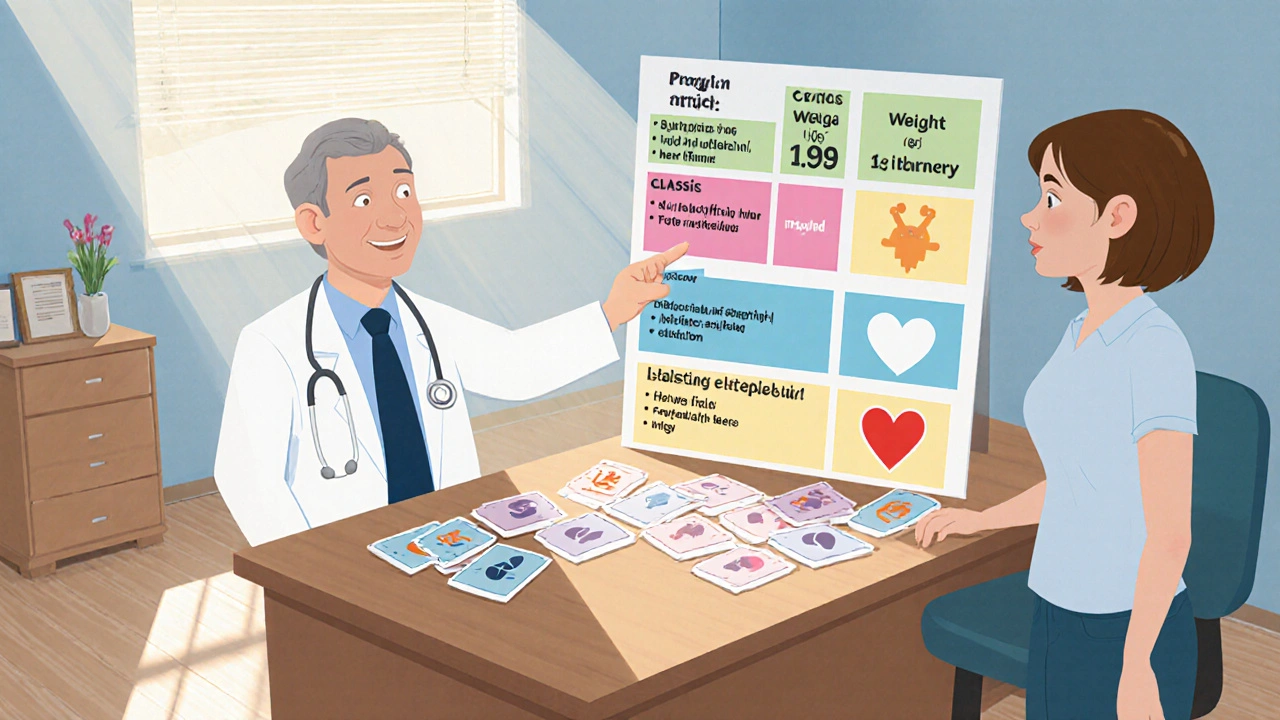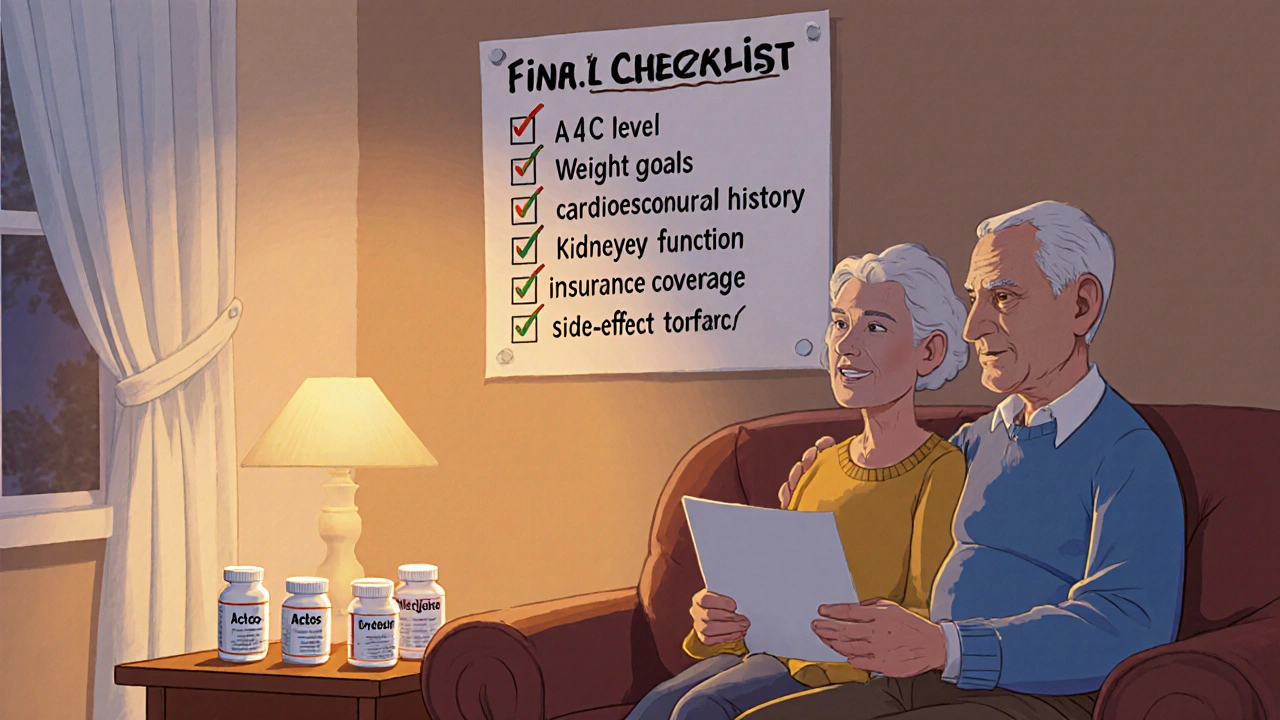Actos (Pioglitazone) vs Top Diabetes Drug Alternatives - 2025 Comparison

Diabetes Medication Decision Tool
Select your health priorities and we'll recommend which diabetes medications might be most suitable for you.
Based on your health profile, these medications are most suitable for you:
Actos (Pioglitazone)
RecommendedExcellent for insulin resistance with moderate A1C control
Cons: Weight gain (+2-4 lbs), fluid retention risk
Metformin
RecommendedFirst-line option for most patients
Cons: GI side effects in some patients
Empagliflozin
RecommendedBest for heart failure patients with kidney protection
Cons: Higher cost, risk of genital infections
Sitagliptin
RecommendedGood for mild A1C control with minimal side effects
Cons: Modest glucose-lowering effect
Rosiglitazone
Not RecommendedGenerally avoided due to heart failure risks
Cons: Higher heart failure risk, FDA restrictions
Insulin
Not RecommendedReserved for advanced diabetes cases
Cons: Hypoglycemia risk, injection required, cost
Important Considerations
Remember that medication selection should always be personalized with your healthcare provider. This tool is for informational purposes only and does not replace medical advice.
Consider discussing these factors with your doctor:
- Insurance coverage and cost
- Current medications and potential interactions
- Other health conditions
- Personal preferences
When it comes to type 2 diabetes, choosing the right pill can feel like a maze. Actos (pioglitazone) is often on the table, but dozens of other meds promise similar blood‑sugar control with different trade‑offs. This guide breaks down how Actos stacks up against the most common alternatives, so you can see which drug fits your health goals, budget, and lifestyle.
Quick Takeaways
- Actos works by improving insulin sensitivity; it’s not a first‑line drug for most patients.
- Metformin remains the cheapest, weight‑neutral starter with solid cardiovascular data.
- Modern agents like empagliflozin and sitagliptin add heart‑protective benefits but cost more.
- Rosiglitazone shares Actos’ class but carries higher heart‑failure warnings.
- Insulin offers the most potent glucose control but requires injections and carries hypoglycemia risk.
How Actos Works - The Basics
Actos belongs to the thiazolidinedione (TZD) class. It binds to PPAR‑γ receptors in fat cells, making those cells more responsive to insulin. The result is lower blood glucose without forcing the pancreas to pump more insulin. Because it targets insulin resistance, Actos can be especially useful for patients who struggle with high fasting glucose despite other meds.
Why Doctors May Reach for Alternatives
Every diabetes drug has a sweet spot, and Actos isn’t the best fit for everyone. Common reasons to look elsewhere include:
- Weight gain - TZDs tend to add a few pounds, which can be a turn‑off for patients trying to lose weight.
- Fluid retention - swelling in the legs or shortness of breath signals the drug’s effect on kidney‑sodium handling.
- Heart‑failure risk - patients with existing HF are usually steered away.
- Cost - newer agents often have insurance rebates that make them cheaper than Actos in some plans.

Head‑to‑Head: Actos vs Popular Alternatives
| Drug | Class | Primary Mechanism | Typical Dose | Effect on Weight | Cardiovascular Impact | Average Monthly Cost (US) |
|---|---|---|---|---|---|---|
| Actos (pioglitazone) | Thiazolidinedione | PPAR‑γ agonist - improves insulin sensitivity | 15‑45 mg once daily | +2‑4 lb (average) | Neutral to modest benefit in large trials (IRIS) | $30‑$45 |
| Metformin | Biguanide | Decreases hepatic glucose production | 500‑2000 mg divided BID | Weight neutral or slight loss | Reduces major adverse CV events (UKPDS) | $4‑$10 |
| Sitagliptin | DPP‑4 inhibitor | Increases incretin levels → more insulin | 100 mg once daily | Neutral | Neutral; modest heart‑failure signal in some sub‑studies | $45‑$55 |
| Empagliflozin | SGLT2 inhibitor | Blocks glucose reabsorption in kidneys | 10‑25 mg once daily | -2‑3 lb (average) | Significant reduction in CV death (EMPA‑REG) | $70‑$90 |
| Rosiglitazone | Thiazolidinedione | PPAR‑γ agonist - similar to Actos | 4‑8 mg once daily | +2‑5 lb | Higher heart‑failure risk; FDA restriction | $35‑$50 |
| Insulin (basal) | Hormone replacement | Directly lowers blood glucose | Variable - 0.1‑0.5 U/kg/day | Neutral | Neutral; hypoglycemia risk can affect CV outcomes | $80‑$120 (including supplies) |
Deep Dive into Each Alternative
Metformin - The Workhorse
Metformin is the go‑to first‑line agent for most newly diagnosed patients. Its low cost, decades‑long safety record, and weight‑neutral profile make it a solid baseline. In the UKPDS trial, metformin‑treated participants saw a 39 % drop in myocardial infarction risk compared with diet alone.
If you’re already on Actos and gaining weight, swapping to metformin (or adding it) might reverse that trend while keeping glucose under control.
Sitagliptin - The Quiet Incretin Booster
Sitagliptin sits in the DPP‑4 inhibitor class. It raises GLP‑1 levels indirectly, which nudges the pancreas to release insulin only when blood sugar is high. That means a low hypoglycemia risk, but the downside is a modest glucose‑lowering effect (A1C drop ~0.5‑0.8 %). Cost is higher than metformin, and cardiovascular data show neutrality rather than benefit.
Empagliflozin - The Kidney‑Based Game Changer
Empagliflozin blocks the SGLT2 transporter in the kidney, dumping excess glucose into the urine. Besides a solid A1C reduction (‑1.0 % to ‑1.5 %), it drives weight loss and dramatically lowers heart‑failure hospitalization. The EMPA‑REG OUTCOME study showed a 38 % cut in CV death. The biggest hurdle is cost and a small risk of genital infections.
Rosiglitazone - The Cousin You Might Skip
Rosiglitazone shares the same TZD mechanism as Actos, so you’ll see similar insulin‑sensitivity gains. However, post‑marketing data linked it to a higher rate of heart‑failure events, prompting FDA restrictions. If you’re already on Actos, there’s rarely a reason to switch to rosiglitazone unless cost is a decisive factor and you have no cardiovascular issues.
Insulin - The Ultimate Backup
When oral meds can’t hit target A1C, many clinicians add basal insulin. It provides the most predictable glucose lowering but requires injection technique and careful monitoring to avoid hypoglycemia. For patients with severe insulin resistance, a combination of Actos and basal insulin can be effective, but the regimen is more complex and pricey.
How to Decide Which Drug Is Right for You
Think of drug selection as a checklist. Grab a pen and go through these points:
- Current A1C level - How far are you from your goal?
- Weight goals - Do you need a drug that helps you lose weight?
- Cardiovascular history - Any prior heart attack, heart‑failure, or stroke?
- Kidney function - SGLT2 inhibitors need good GFR; TZDs can stress the kidneys.
- Insurance coverage - What does your plan cover?
- Side‑effect tolerance - Are you okay with potential edema or urinary infections?
Match your answers against the table above. If weight loss and heart protection matter most, empagliflozin jumps to the top. If cost and proven safety dominate, metformin stays king. If insulin resistance is the core issue and you can handle a few extra pounds, Actos may still be the best fit.

Common Pitfalls and How to Avoid Them
- Mixing TZDs with high‑dose sulfonylureas - Increases hypoglycemia risk without added benefit.
- Ignoring liver function tests - Pioglitazone can raise liver enzymes; baseline labs are essential.
- Overlooking fluid retention - Patients on diuretics or with NYHA class II‑III heart failure should avoid Actos.
- Assuming “once‑daily” means “no monitoring” - All diabetes meds need periodic A1C checks, kidney labs, and weight tracking.
Bottom Line: Tailor the Choice to the Person, Not the Pill
No single drug wins on every front. Actos shines when you need a potent insulin‑sensitizer and can manage the modest weight gain. Metformin dominates on cost and weight neutrality. Empagliflozin leads for heart‑failure patients who also want weight loss. Sitagliptin offers a gentle, low‑hypoglycemia option for those who can afford it. Rosiglitazone is generally a fallback when insurance forces a cheaper TZD. Insulin caps the arsenal for anyone who needs the strongest glucose pull.
Talk to your doctor, bring your lab results, and weigh the pros and cons side by side. The right drug will keep your A1C in range, align with your health priorities, and fit your pocket.
Frequently Asked Questions
Can I take Actos with Metformin?
Yes. Combining a TZD like Actos with metformin is a common strategy. Metformin handles hepatic glucose output, while Actos improves peripheral insulin sensitivity. The combo often yields a larger A1C drop than either alone, but watch for fluid retention.
Why does Actos cause weight gain?
Pioglitazone activates PPAR‑γ receptors, which promote fat storage in subcutaneous tissue. The extra fat is a side effect of the drug’s insulin‑sensitizing action.
Is empagliflozin safe for people with kidney disease?
SGLT2 inhibitors need a glomerular filtration rate (GFR) of at least 30 mL/min/1.73 m². Below that, the drug loses efficacy and the infection risk rises. Always check kidney labs before starting.
Do I need to stop Actos before surgery?
Most surgeons recommend holding TZDs 48‑72 hours before major surgery to reduce fluid‑retention risk. Your endocrinologist will give a personalized plan.
Which drug has the best heart‑failure data?
Empagliflozin leads the pack. The EMPA‑REG OUTCOME trial showed a 35 % reduction in heart‑failure hospitalization compared with placebo. Some SGLT2 agents share this benefit, but empagliflozin remains the most studied.
Dana Yonce
October 21, 2025 AT 16:08Actos can be a decent step‑up if you’re okay with a few extra pounds 😊
Lolita Gaela
October 24, 2025 AT 16:08From a pharmacodynamic standpoint, pioglitazone’s PPAR‑γ agonism modulates transcription of adiponectin and GLUT4, resulting in enhanced peripheral glucose uptake without substantial hepatic gluconeogenesis suppression-a mechanism distinct from metformin’s AMPK activation.
Giusto Madison
October 27, 2025 AT 16:08Look, if your A1C is stuck around 8.2 % and you’re already on metformin, adding a TZD like Actos can shave off 0.5–0.7 %.
The drug works by binding PPAR‑γ and improving peripheral insulin sensitivity, which can be especially useful for patients with high fasting glucose.
Clinical trials have shown modest reductions in HbA1c without increasing the risk of severe hypoglycemia.
However, you should monitor your weight because the average gain is about 2–4 lb.
Fluid retention is another side effect; some people develop ankle edema that can be mistaken for heart failure.
It’s wise to get a baseline liver panel before starting, as pioglitazone can raise transaminases in rare cases.
If you have a history of heart failure, you might want to avoid it altogether.
For patients with stable cardiovascular disease, the IRIS trial suggested a neutral to modest benefit, but evidence isn’t as strong as with SGLT2 inhibitors.
Insurance coverage can be tricky; some plans place Actos on a higher tier than metformin, making it more expensive out‑of‑pocket.
Adding a low‑dose diuretic can help mitigate the edema if you decide to stay on the drug.
Combine Actos with a GLP‑1 receptor agonist, and you might see additional weight loss, though cost will increase.
Remember to re‑check A1c every 3 months after any medication change to gauge effectiveness.
If you don’t see at least a 0.5 % drop after 6 months, consider switching to an SGLT2 inhibitor instead.
Many clinicians reserve Actos for patients who are already on metformin and a DPP‑4 inhibitor but still need extra glucose lowering.
Ultimately, the decision should balance your glycemic targets, side‑effect tolerance, and financial situation.
Sakib Shaikh
October 30, 2025 AT 16:08Yo bro, you’re talkin’ about “shaving off” A1C like it’s a beard! But seriously, the fluid retention can turn your ankles into a swamp-don’t ignore that, or you’ll be floatin’ like a ghost.
Devendra Tripathi
November 2, 2025 AT 16:08All that fancy PPAR‑γ talk sounds impressive, but in real‑world practice the cardiovascular benefit is practically nil compared to a cheap SGLT2 inhibitor. I’d dump Actos for empagliflozin any day.
Vivian Annastasia
November 5, 2025 AT 16:08Oh sure, because paying $80 a month for a drug that makes you pee out glucose is totally “real‑world” affordable for everyone-nice theory.
Nick M
November 8, 2025 AT 16:08Honestly, most of these tables just hide the fact that pharma pushes the newest meds to keep us buying, while the old cheap drugs still work if you follow diet.
eric smith
November 11, 2025 AT 16:08Wow, you actually think “diet” beats proven CV mortality data from EMPA‑REG? That’s adorable.
Erika Thonn
November 14, 2025 AT 16:08maybe the real question is not which drug makes a lower A1c, but how we see the balance between greese and health-life is a balance.
Jake Hayes
November 17, 2025 AT 16:08Actos is outdated; stick with metformin and lifestyle.
Angela Koulouris
November 20, 2025 AT 16:08Hey, don’t be so hard on yourself-every patient’s journey is unique, and sometimes a combo of metformin and a low‑dose TZD can be the bridge to better control.